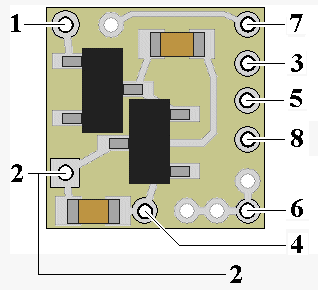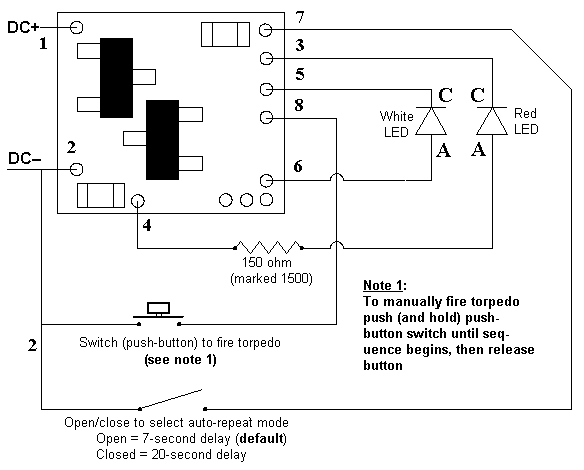Best viewed using:
Internet Explorer
or
Mozilla Firefox
Connecting the N8091 Photon Torpedo Simulator
Installing the N8091 is very straightforward. Its tiny size and thin construction will allow it to be placed nearly anywhere in any scale model. Because the module has circuitry on both sides, care must be taken to be sure that the components or wires soldered will not make contact with any metal object causing a short circuit.
The Simulator can be powered by battery or any well-filtered and regulated DC power source with an output of 6-18VDC.
Included with these modules are three 6” lengths of #32 insulated wire. If necessary, these can be used for power and input control wires. If used, we recommend the red wire be used for the + DC connection. It would be connected to solder point 1 as shown in Fig. 1. This wire could also connect through a switch to the + DC connection for remote control of the lighting effect. The black wire should be connected to – DC and to solder point 2. The violet wire can be used for input control. See figure 2 below for details regarding this feature.

Figure 1
Important note: A low-wattage iron with a pointed tip should be used for connection of wires. Too much heat or solder can easily damage the wires or module and void the warranty.
Also, all connecting wires should be pre-tinned before soldering them to the module. This will make connection quick and easy and ensure excessive heat is not applied to the solder points.
Solder point #2 is the -DC (or ground) power connection.
Connecting LEDs
When connecting the LEDs, proper polarity must be observed. LEDs are “polarity sensitive” and will not function if connected backwards. The N8091 is configured for the connection of two 20 ma LED. One with a device voltage of 1.75-2.0 VDC connected to solder points 3 & 4 (this covers all of Ngineering’s Micro and Nano red LEDs, as well as many red LEDs available). A second LED with a device voltage of 3.2-3.6 VDC connected to solder points 5 & 6 (this covers all of Ngineering’s 2x3mm, Micro and Nano white LEDs, as well as many white LEDs available).
The N8201 has on-board current limiting resistance to protect the (white) LED connected to solder points 5 & 6.. Additionally, included with this module, is a 1/8-watt 150-ohm (marked 1500) SMD resistor (plus a spare) to be used for current protection of the red LED that will be connected between points 3 & 4.
Using wire appropriate for the size of the LED and its placement in the model, connect the white LED cathode (the
– connection) to point 5 on the module and its anode (the +) to solder point 6. Connect the red LED cathode (–) to solder point 3, and its anode (+) to to one side of a 150-ohm resistor, and connect the other side of that resistor to point 4 on the module. See Fig. 2 (on back this instruction sheet) for a schematic layout of LED hookup.

Figure 2
Simulator Configuration Options:
1. Manual firing with auto-repeat enabled: If auto-repeat firing of the photon torpedo is desired but manual firing is needed on demand, it is recommended that a push-button switch be wired into this circuit for easy control. Wire the push-button switch between point 2 and point 8 as shown in figure 2 (on back). To manually fire the torpedo, push and hold the push-button switch until the firing sequence starts, then release the button. In manual mode the torpedo can be fired approx. every 2 seconds. Without manually firing, the photon torpedo will auto-repeat firing at timing set by solder point 7 (see paragraph 3).
2. Manual only firing (no auto-repeat):
If you intend to only manually fire the torpedo, (no auto-repeat mode), simply wire a push-button switch, into either power connection (+DC point 1, or –DC point 2) of the Simulator. Press & hold the button and the torpedo will fire after 1/4-second. Sure to hold the push-button closed for the full firing sequence, otherwise the Simulator will lose power and the sequence will stop short.
3. Automatic firing mode:
As mentioned in the previous paragraph, the default mode for the N8091 (without manually firing) is auto-repeat firing once every 7 seconds. An alternate auto-repeat mode is to have the torpedo fire once every 20 seconds. To set this timing sequence, connect a wire from solder point 7 to point 2 (DC–).
For additional flexibility a switch could be wired between point 7 and point 2. This would allow either auto-repeat timing sequence to be selected.
Once again, be sure to use a low-wattage soldering iron when connecting wires to the module.
Our N40M2 12-watt Iron with either the N408I (iron clad) Needle Tip, or the N408X (bare copper) Needle Tip would be an excellent choice for this operation.
This completes connection of the N8091. It is recommended that a thorough re-inspection of all connections and module placement be performed prior to applying power to your model. We hope you enjoy the added realism our module provides.
© 2018 Ngineering





















